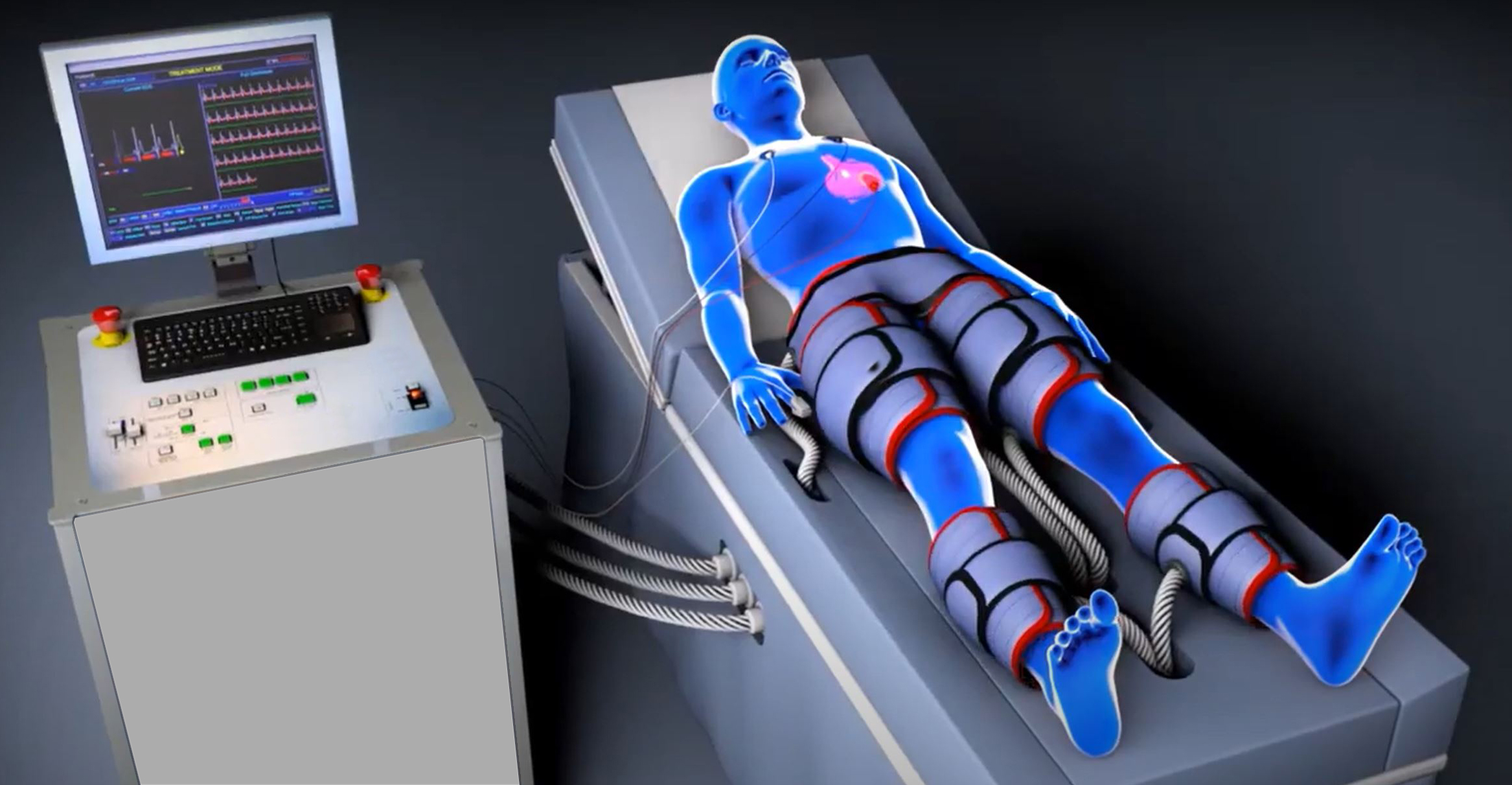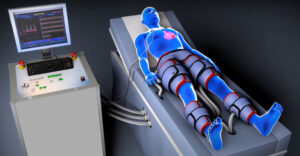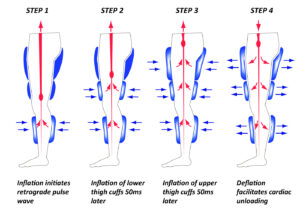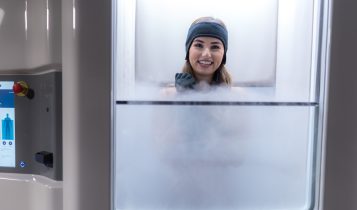
1 hour session where cuffs apply firm but gentle pressure while your heart is in the off beat phase.
-
Facebook
-
Twitter
-
Reddit
-
Pinterest
-
Email
The heart muscle, like any muscle, requires large amounts of oxygen while functioning. The coronary arteries deliver blood all around the heart to allow this. Still, when blocked, the blood arrives with problems and causes pain, resulting in angina pectoris.
The Enhanced External Counter-Pulsation (EECP), an electrocardiogram-led sequential compression of lower limbs, is a therapy that helps blood flow to the heart to relieve angina and heart failure. Because of how it works, it is nowadays also proposed as a beneficial treatment for enhancing exercise recovery in athletes.
The heart is a primary organ for any athlete. In addition to keeping you alive, it is responsible for pumping blood at full speed while you exercise intensely. At the same time, your muscles begin to take energy from carbs and fats, making you lose weight. When these run out, they take carbohydrate reserves (glycogen) and transform them into lactic acid, the chemical responsible for the next day’s muscle pain.
Just as lactic acid is a friendly side effect of exercise, other chemicals are released during recovery, making it a slow and somewhat painful phase. After training, there is usually inflammation, increased cortisol and creatine kinase (an indicator of muscle damage), and muscle soreness. Most of them are due to metabolic activity and physical wear and tear during training.
EECP synchronizes the pressure in the lower limbs vessels with every heartbeat to increase blood flow to the heart without pumping at its total capacity. Thus, the more oxygenated blood flowing through the body, the less side chemicals build up and, therefore, the faster the body recovers after each workout. Let’s find out what this is all about in more depth.

1 hour session where cuffs apply firm but gentle pressure while your heart is in the off beat phase.
What happens in your body when you exercise?
During the first ten minutes, your body reacts smartly to the increased muscle activity by inhibiting and stimulating specific systems and organs.
There is an increase in heart and respiratory rate, sweating, increased body temperature (hot sensation), fatigue, and muscle pain (burning sensation). At the same time, the resting functions are deactivated, and for example, the digestive system slows down.
Chemicals such as adrenaline and noradrenaline are released during the first hour of workout, first through the nervous system and then from the adrenal gland. In addition to these, other chemical mediators such as cortisol, testosterone, growth hormone, which regulate the functions of different organs and coordinate the body’s responses to intense activity.
In terms of breathing, ventilation increases progressively, first by a greater depth of breaths and then by an increase in respiratory rate. This allows us to take more oxygen from the air for the muscles working non-stop and eliminate the carbon dioxide excess due to combustion and blood pH.
As for the heart, it contracts with more energy so that more blood flows through it, which, together with the increase in heart rate, improves the amount of blood that also travels through your whole body in one minute.
Although all of the above changes are beneficial to your body, studies have shown that harmful chemicals are also released during exercise due to increased metabolism. These include creatine kinase (CK), lactate dehydrogenase (LDH), and c-reactive protein (CRP).
All three mean anaerobic metabolism, which muscles undergo when they run out of energy sources, such as carbohydrates or fats, and are also responsible for the dreaded tiredness and muscle pain the day after exercising, also known as delayed onset muscle soreness (DOMS).
The recovery phase and the role of EECP
Muscle recovery after exercise is one of the key elements for any athlete, along with nutrition, hydration, and warm-up/stretching. The recovery process is the muscle’s way of meeting the body’s metabolic and strength demands, increasing its size by growing its fibers to be strong enough to withstand the next workout.
It’s normal for muscles to become exhausted during workouts, making you lose weight while gaining muscle mass. Your tissues repair themselves and gain strength during this process.
On average, a muscle needs 24 to 48 hours to get rid of the above-mentioned toxic substances and repair tissues that have been worn down during the training. However, this recovery phase can be slower and very painful in some people, and the reason for seeking alternatives for enhancing the process.

EECP Therapy creates new blood vessels in the heart and improves blood flow.
What is EECP?
As mentioned earlier, EECP, defined as Enhanced External Counter-Pulsation, is a unique and non-invasive therapy based on an electrocardiogram-led sequential compression to the lower limbs.
This technique allows the blood pressure in the lower limbs to be synchronized with the heartbeat, so more blood can reach the tissues and the heart to improve overall blood flow. It is called ”enhanced” because the current equipment has been perfected since 1993.
What does the therapy consist of?
EECP sessions are performed after training and last between 30 minutes and an hour. The pressure applied to the lower limbs varies, although the most recommended is 220-300 mmHg to cause an increase in diastolic cardiac pressure.
Three air inflatable pneumatic cuffs are placed around your legs (one on the calf, one on the lower thigh, and a third on the upper thigh and buttocks) while you are lying on a stretcher. At the same time, you will have sensors (electrodes) on your chest to monitor how your heart is working.
Each time your heart beats, the cuffs on your legs grow with compressed air to press your legs. Compressing the legs also compresses the blood vessels within them, boosting oxygen reaching the tissues. This enhances the athlete’s performance by reducing lactic acid and cortisol levels and relieving muscle inflammation while improving exercise endurance.
When the heart-leg pressures sequence is right, the pressure against which the heart must pump decreases (afterload) and increases blood return to the heart (preload), thus helping the heart function more optimally.
Is it really suitable for athletes?
Several studies have proven the efficacy of EECP therapy on muscle biomarkers in all types of exercise, both cardiovascular and weight-bearing.
For example, author Ruben Collins of the University of Dublin and colleagues recently found that EECP therapy for at least 20 minutes after training decreased cortisol, reduced catabolism (metabolic pathways that break down molecules into smaller units), and increased protein synthesis. They also observed that those who received the treatment had higher levels of immunoglobulin A, an essential antibody for better immune response, especially for your gut 1.
Other studies have found that EECP therapy significantly decreases all biomarkers of inflammation, muscle damage, and the typical post-training soreness (DOMS) 2.

The EECP machine applies pressure during on the off beat of the heart.
What to expect from the therapy?
In short, during each session, the athletes experience massive and passive cardiovascular training simultaneously, where the heart is at rest (without increasing its rate) but receives more blood due to increased circulation as if it were in intense activity.
After each EECP treatment, you may notice that:
- You can walk farther without feeling tired or sore.
- You lift heavier things.
- You feel more active.
- There is less muscle pain.
- You can return to your daily activities without pain or fatigue.
What are the benefits of EECP therapy?
EECP plays a leading role in increasing collateral blood flow to the cardiac muscle to improve overall cardiovascular health. This provides countless benefits, such as:
- Increases energy levels massively.
- Reduces lactic acid and thus body fatigue.
- Naturally enhances endurance and stamina from the rigors of training.
- Decrease in recovery time between workouts, so you can exercise the next day without any problem.
- Helps reduce risks of sports injury.
In addition, it is a scientifically based therapy, so it is safe and recommended by specialists in the field.
Why choose EECP therapy over other therapies?
Athletes need optimal muscle recovery since training success depends on how often they train. Nutrition, hydration, rest, and massage are undoubtedly good ways to pay attention to this process, although they alone may not be enough, much less for those who train intensely.
Lactic acid and creatine kinase may not go away easily with diet or cold baths alone, and for this, science-based complementary therapies play an important role. EECP treatment is that extra your body need after training.
If you feel exhausted, sore, or tired after every workout, then you are most likely a candidate for EECP recovery therapy. Don’t hesitate to ask for your first session. Your body will thank you after each session.

